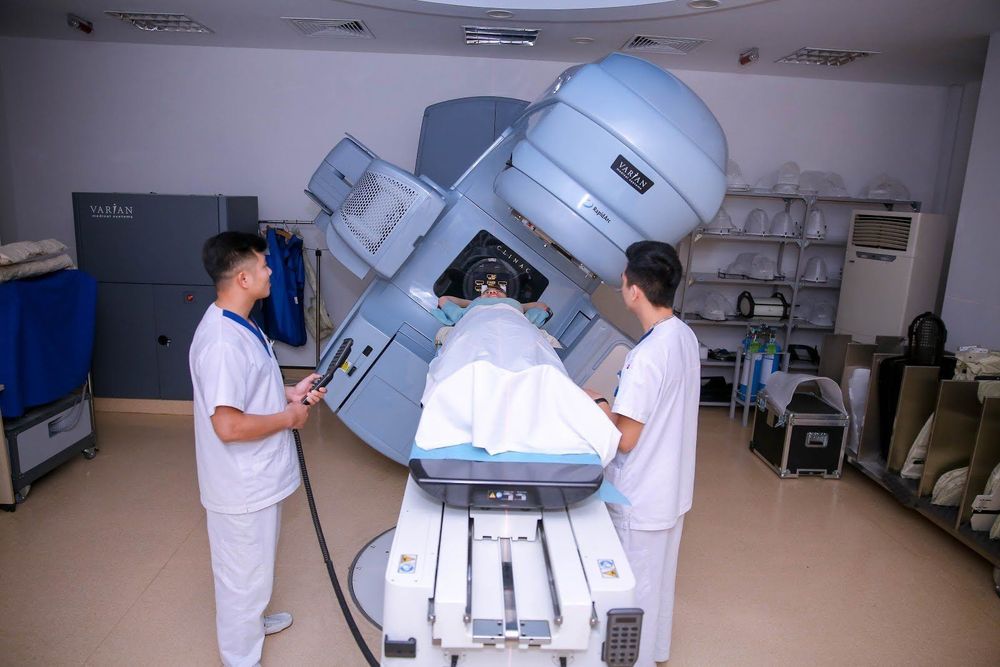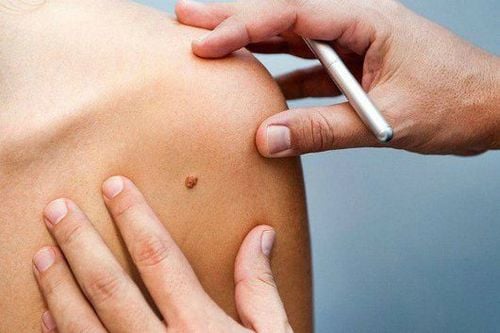This is an automatically translated article.
Squamous cell carcinoma is a common form of skin cancer and is usually found on areas of the body such as the head, neck, chest, upper back, ears, lips, arms, legs and hands. by UV rays from the sun.1. What is squamous cell carcinoma?
Our skin is made up of many different layers. The outer protective layer (epidermis) is made up of squamous cells, including basal cells and melanocytes. These cells are constantly shed to make room for new skin cells. However, when a genetic change occurs in the DNA of any of these cells, it can cause skin cancer. The main types of skin cancer are squamous cell carcinoma, basal cell carcinoma, and melanoma.Squamous cell cancer (SCC) is a type of skin cancer that begins in the squamous cells. These are thin, flat cells located in the outermost layer of the skin. SCC is caused by changes in the DNA of these cells, causing them to multiply uncontrollably.
According to the Skin Cancer Foundation, SCC is the most common form of skin cancer. About 700,000 people in the United States are diagnosed with this type of cancer each year. SCC usually develops on areas of the skin that are frequently exposed to UV radiation. In some cases, it can occur in other areas of the body.
Squamous cell carcinoma grows fairly slowly, but it can spread to nearby tissues, bones, and lymph nodes and become difficult to treat. Squamous cell cancer can be easily treated when caught early.
Trắc nghiệm: Thử hiểu biết của bạn về bệnh ung thư
Ung thư là nguyên nhân gây tử vong hàng thứ 2 trên thế giới. Thử sức cùng bài trắc nghiệm sau đây sẽ giúp bạn có thêm kiến thức về yếu tố nguy cơ cũng như cách phòng ngừa bệnh ung thư.
Bài dịch từ: webmd.com
2. Symptoms and diagnosis of squamous cell carcinoma
Squamous cell cancer usually starts as a dome-shaped bump or a patch of red, scaly skin that is rough and may bleed easily when shaved. As it grows larger it can be itchy or painful. Squamous cell cancer can also appear through scars or chronic skin sores.
To diagnose squamous cell cancer, a dermatologist who specializes in skin conditions will ask about the patient's medical history and symptoms. The doctor will then examine the spot's size, shape, color and texture, and check the lymph nodes to make sure they're not larger or harder than usual. If in doubt, the doctor will take a skin biopsy for testing.

3. Causes of squamous cell cancer
UV radiation is the most common cause of DNA mutations that lead to skin cancer. UV radiation is found in sunlight and in lamps.
In addition, many people can also inherit or develop squamous cell cancer due to a weakened immune system that increases the likelihood of skin cancer. People who have received radiation treatment for other skin conditions also have a higher risk of skin cancer.
4. Treatments for squamous cell cancer
Squamous cell carcinoma can often be treated with minor surgery. Depending on the size and location of the SCC, your doctor will choose the right treatment. Most squamous cell skin cancers, if found and treated at an early stage, can be eliminated or eliminated with local treatments. Squamous cell cancer, once large, is more difficult to treat, and has a higher growth rate.
In rare cases, squamous cell cancer can spread to lymph nodes or distant parts of the body. If this happens, treatments such as radiation therapy, immunotherapy, or chemotherapy may be needed. Here are the commonly used groups of SCC treatments:
4.1 Surgery
Surgical excision: During a surgical excision, the doctor removes cancer cells and a thin layer of healthy skin in the surrounding area to make sure the entire area of cancer has been removed. cancel. The removed skin sample will be sent to the lab. Electrosurgery (also known as curettage and electrocautery): A procedure to remove cancer cells by burning the skin. This process is usually done several times to ensure complete treatment and complete removal of the cancer. This approach is sometimes useful in treating small squamous cell cancers (less than 1cm), but it is not recommended for larger tumours. Mohs surgery: In this surgery, your doctor uses a scalpel to remove the abnormal skin and some surrounding tissue. This skin sample will be examined under a microscope. This process is repeated until no cancer cells are found. Mohs surgery is especially useful for squamous cell cancers that have a high risk of coming back, such as tumors larger than 2cm, cancer that has come back after other treatments, the cells Cancer is spreading along nerves under the skin and cancer is in certain areas of the face or genital area. This approach is often more complicated and time consuming than other types of surgery. Lymph node surgery: The patient will have to remove a piece of the lymph node. During the procedure, the patient will have to use general anesthesia. Cryosurgery: Your doctor will use liquid nitrogen to freeze and destroy cancerous tissue. Like electrosurgery, this treatment is repeated several times to make sure all cancerous tissue has been removed.
4.2 Cryotherapy
Cryotherapy (cryosurgery) is used for some early-stage squamous cell cancers, especially in those who can have surgery, but is not recommended for larger invasive tumors or in certain parts of the nose, ears, eyelids, scalp, or legs.
4.3 Radiation
Uses high energy X-rays to kill cancer cells.
4.4 Photodynamic therapy
Photodynamic therapy (a photosensitive solution applied to the skin that is then activated by light or daylight, or sometimes with intense pulsed light).
4.5 Radiation therapy
Radiation therapy is often a good option for patients with advanced cancer, especially in areas that are difficult to operate (such as eyelids, ears, or nose) or for patients who can have surgery. It is not often used as the first line of treatment for patients because of the possible risk of other problems.

4.6 Treatment of advanced squamous cell cancer
Lymph node dissection: Removing lymph nodes may be recommended for some squamous cell cancers that are very large or have grown deep into the skin, as well as if the lymph nodes feel enlarged and/ or hard. The removed lymph nodes are looked at under a microscope to see if they contain cancer cells. Immunotherapy Systemic chemotherapy or targeted therapy: This may be an option for patients with squamous cell cancer that has spread to lymph nodes or distant organs. These types of treatments can be combined or used separately.
5. How to prevent squamous cell carcinoma
Avoid the sun during the hottest time of the day, which is between 10am and 4pm. Wear a sunscreen with an SPF of at least 15 every time you go out in the sun. Wear sunglasses with UV protection. Protect your skin during winter also because winter rays can be especially dangerous. Check your skin every month for any new or unusual growths.
People who have been diagnosed with skin cancer are more likely to have a recurrence - so it's important to see your doctor for regular skin checks. Use preventive supplements like nicotinamide (vitamin B) and Heliocare (polypodium leucotomos fern extract).
To register for medical examination and treatment at Vinmec International General Hospital, you can contact Vinmec Health System nationwide, or register online HERE.
Articles refer to sources: webmd.com, healthline.com, cancer.org
SEE MORE:
Reduce cancer risk: Lifestyle changes - Focus on screening "Miracle" to return people's faces for 10 years skin cancer 15 common warning signs of cancer













